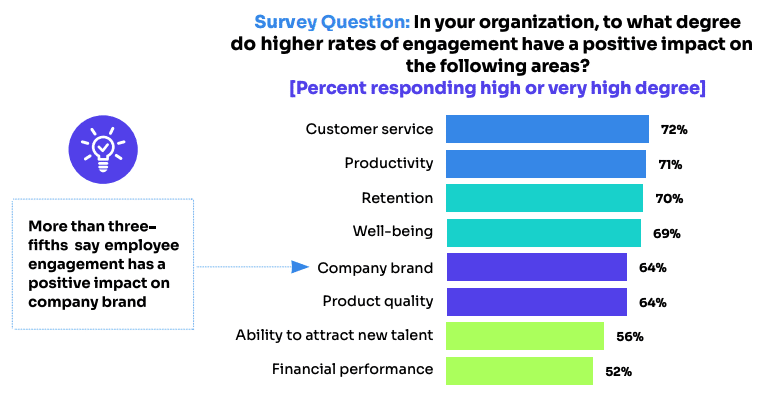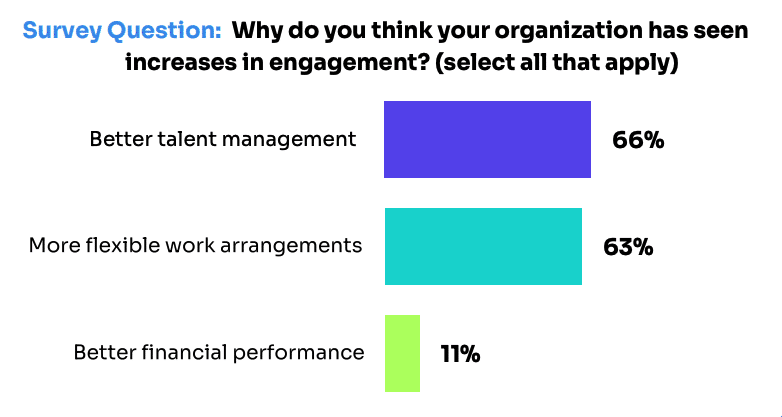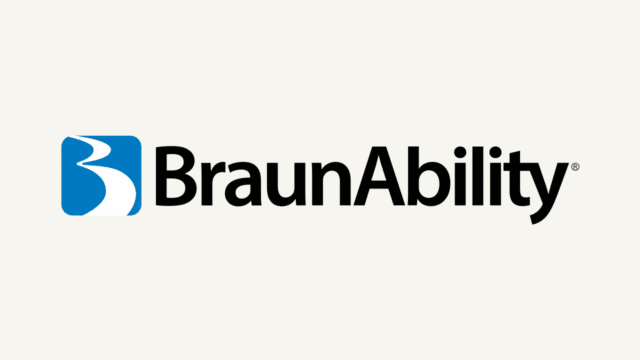Table of Contents
Employee engagement in 2022 took a hard hit with worldwide resignations, mass layoffs, and quiet quitting. In addition, the uptick in remote work created a lack of deeper connection. To really understand how employee engagement has been affected within the workplace, WorkTango partnered with HR.com to survey 275 HR professionals from all over the globe, representing almost every industry and business size. Here are some of our major findings.
The saying goes, “employees leave managers, not organizations.” Some may argue the narrowness of the point, but what we can unhesitatingly affirm is this: leaders play an integral part in employee — and ultimately, business — success.
Since employees are the backbone of any organization, nurturing and engaging them should be at the top of any leader’s to-do list. In other words, business growth sits in the hands of its leaders. If this seems like a big responsibility, it is.
So, how can leaders take the reins and create an engaged culture where employees are fulfilled in their jobs?
WorkTango recently partnered with HR.com to tackle the topic of employee engagement. In this research study, we asked 275 HR professionals about employee engagement to determine why some organizations have higher engagement than others.
Here’s what we know about highly engaged organizations compared to less engaged ones:
- They are more than twice as likely to give employees the chance to do meaningful work well
- They are more than twice as likely to listen carefully to employee feedback
- They are over three times as likely to maintain a positive work culture
For highly-engaged organizations, the result is impressive. Almost three-fourths of highly engaged organizations say employee engagement improves customer service, and over two-thirds say it improves productivity, retention, and well-being.

Knowing this, it’s no wonder that more than three-fifths (62%) of the HR professionals we surveyed place employee engagement at or near the top of their list of priorities.
In response to our research study, we wrote a 3-part series addressing the data we found on employee engagement. In the first two articles, where we covered the decline of employee engagement and the benefit of surveys and continuous feedback, we hammered in the idea that engagement starts with leadership.
In this article, we’re going to take a look at how leaders are currently handling employee engagement and what steps they can take to appreciate, recognize, and empower their employees.
Whose responsibility is employee engagement, anyway?
From middle management to CEO, leaders carry a variety of titles. But essentially, they all have parallel responsibilities: to motivate individuals within a group to achieve a goal or mission.
When it comes to engaging employees, we wanted to know which leaders tend to have the most responsibility. The results show us that leaders share nearly equal responsibility for employee engagement.
Here’s where our respondents placed responsibility:
- 66% of respondents said immediate supervisors are responsible for engagement
- 66% said Human Resources
- 62% said top leadership
- 44% said employees themselves
According to these stats, top responsibility in most organizations falls on immediate supervisors and Human Resources departments.
This makes sense since Human Resources often develop policies to improve engagement, while direct supervisors play a key role in determining the employee experience. And top leaders fall closely behind because their support drives initiatives.
Leaders aren’t doing enough
So while organizations seem to know that employee engagement falls in the hand of leaders, there’s still not enough being done.
We asked HR professionals which factors are most prevalent when seeking to improve engagement in their organization.
The results show that nurturing, learning and development, and growth opportunities are high on the list.
- 61% of organizations provide employees with learning opportunities
- 52% provide activities intended to nurture a positive corporate culture
- 41% provide employees with career growth advice
- 40% encourage employees to manage their own engagement levels
However, leadership involvement and training seems to be low:
- Only 22% said senior leaders prioritize employee engagement
- Only 18% train managers in how to boost employee engagement
- Only 13% invest in engagement-related resources
- Only 10% believe most of their managers are skilled at fostering employee engagement
While handing employees resources to do their job well is important, employee engagement is so much more than this. Leaders must take charge when it comes to helping employees feel safe and included, building trust, and recognizing and rewarding hard work.
How leaders are currently driving engagement
When asked to what degree leaders are driving engagement, we found that, to a high or very high extent, only:
- 45% of leaders foster collaboration
- 40% of leaders recognize superior contributions
- 37% of leaders build trust
- 36% of leaders take time to listen to feedback or to communicate clear expectations to employees
- 33% of leaders remove barriers to good performance
- 24% of leaders spend time coaching employees to develop strengths
These numbers are a bit discouraging, especially considering the financial costs of a disengaged workforce.

Leaders in highly-engaged organizations tend to be much better at talent management
The good news is that there’s a direct correlation between highly-engaged organizations and talent management that is attentive to employee success.
In fact, two-thirds of survey respondents with higher employee engagement credited better talent management. On the flip side, more than two-thirds of organizations with lower engagement over the past year say it’s due to poor talent management.
Here at WorkTango, we believe that fostering employee engagement involves a collective effort from top management, human resources, immediate supervisors, and employees themselves.
And highly-engaged organizations seem to agree.

Our results show that highly engaged organizations are much more likely to place improved employee engagement responsibility on all stakeholders:
- 84% of highly engaged organizations say immediate supervisors are responsible, compared to only 53% of less engaged organizations
- 70% say Human Resources are responsible, versus only 59% of less engaged organizations
- 70% say top leadership is responsible, versus 50% of less engaged organizations
- 63% say the employees themselves are responsible, compared to 33% of less engaged organizations
As a result, highly engaged organizations are:
- Five times more likely to have senior leaders prioritize employee engagement
- Six times more likely to invest enough in engagement-related resources
- Twelve times more likely to have managers that are highly skilled at fostering engaged individuals and teams
- Almost three times as likely to recognize superior contributions
- More than four times as likely to take time to listen to feedback
- Five times as likely to build trust
Propel engagement by appreciating employees
It’s clear that organizations that prioritize employee engagement also prioritize leadership responsibility. To put it simply, involved leaders who genuinely care about employee success will drive positive business outcomes.
So how can leaders nurture and engage their employees — especially in the era where employees span across states, countries, or even continents?
Leverage the power of recognition and rewards.
In our article addressing surveys and continuous feedback to combat low employee engagement, we talked about the need to measure employee engagement — then act on it. In this article, we’re addressing the third part of a powerful employee engagement strategy: recognition and rewards.
We asked survey respondents which of the following tasks leaders in their organization regularly use to increase engagement.
Here’s what we found:
- 62% ensure employees have necessary work resources and give employees the chance to do meaningful work well
- 51% maintain a positive work culture
- 46% listen carefully to employee feedback
Interestingly enough, creating a place where employees can excel in their jobs is a higher priority, yet praising and rewarding employees once this work is done seems to be almost forgotten.
- 44% share others’ praise with them, such as a compliment
- 35% host celebrations
- 34% offer employees specific recognition for their performance
- 32% invest in programs intended to boost their performance
We believe that some employers are missing the mark. Yes, ensuring employees have necessary work resources is important, but that alone will not create a culture of engaged employees. Acknowledgment, appreciation, and praise — they all play a key role in the employee engagement strategy.
Benefits of recognizing and rewarding employees
A Deloitte study revealed that 85% of professionals want to hear “thank you” in day-to-day interactions. This really should be no surprise since, at every human core, the need for appreciation runs deep.
Think about the sense of pride or fulfillment employees feel when they’ve completed a project which they’ve poured their heart and soul into. Yet, when others notice and give compliments, those feelings are multiplied.
This is why recognizing and rewarding employees should be a strategic part of any employee engagement solution.
Paired with surveys and continuous feedback, a recognition and rewards strategy amplifies key values and behaviors by:
- Empowering every team member to show visible appreciation
- Celebrating wins, big and small
- Creating a catalog of rewards, where employees can redeem points for the things they love
- Using fun incentives to encourage learning and development, wellness, and other company priorities
- Encouraging public and private recognition in any direction, with or without reward points
Appreciation — as simple as it may be — increases employee confidence, elevates performance, and increases retention. To put it another way, recognizing and rewarding employees is a retention strategy that employers can’t afford to miss.



